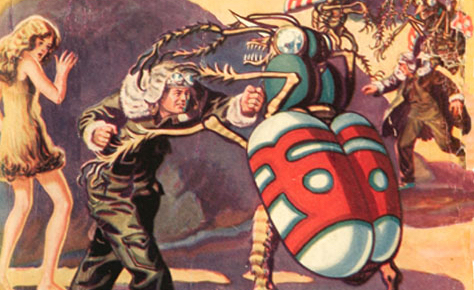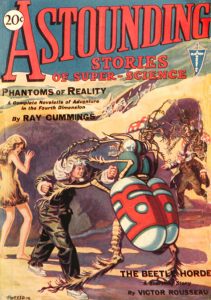
The Beginning of a Legacy
Happy birthday to ASTOUNDING/ANALOG magazine! It has been in continual production since late 1929. Its editors are some of the most influential in the field, and have shaped science fiction destiny for nine decades. The title may have changed, but the magazine’s original purpose — to tell stories that are scientifically accurate and vividly told — remains true to this day.
ASTOUNDING STORIES OF SUPER-SCIENCE launched as a Clayton magazine with Harry Bates as editor. Its first issue was dated January 1930. Clayton paid much better rates than AMAZING and WONDER STORIES — two cents a word upon acceptance as opposed to half a cent a word — and drew better-known writers such as Ray Cummings, Murray Leinster, Jack Williamson, and Victor Rousseau. Although the editors’ original intent was to include stories which “forecasted scientific achievements of To-morrow,” in practice the Clayton ASTOUNDING was primarily an action/adventure pulp magazine.
While the magazine was successful, poor business decisions made during the Great Depression stretched Clayton’s resources. In 1933 they went bankrupt and ASTOUNDING became part of the Street & Street line. The magazine’s new publisher was no stranger to successful pulps magazines as THE SHADOW and DOC SAVAGE were also their properties, both with big circulation numbers. The first Street & Street issue of ASTOUNDING STORIES — dated October 1933 — hit the stands with F. Orlin Tremaine as editor.
In the December 1933 number, Tremaine began a discussion forum called “Brass Tacks.” It has run continuously since then. In that first column, Tremaine wrote a statement of editorial policy. He called for “thought variant” stories to open “the way for real discussion . . . connected with social science, the present condition of the world, and the future.” The magazine published some fascinating thought variant stories — Jack Williamson’s “The Legion of Space,” Murray Leinster’s “Sidewise in Time,” “The Bright Illusion,” by C. L. Moore, and “Twilight,” by John W. Campbell.
Space opera remained popular and ASTOUNDING serialized both “The Skylark of Valeron,” by E. E. “Doc.” Smith, and “The Mightiest Machine,” by John W. Campbell. By the middle of 1934, the magazine’s circulation was up to an estimated 50,000. By the end of that year, ASTOUNDING was the clear leader in the field.
John W. Campbell, Jr.
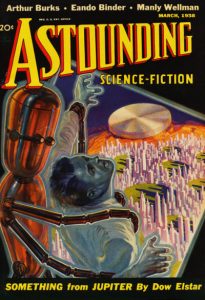 It’s fair to say that John W. Campbell, Jr. is the most influential editor in science fiction history. He succeeded Tremaine and gained full editorial control of ASTOUNDING as of the March 1938 issue. Campbell continued as editor until 1971. During those thirty-four years, he developed not only a superior stable of writers, but also changed the face of science fiction for all time. The “Golden Age of Science Fiction” began when Campbell became editor of ASTOUNDING.
It’s fair to say that John W. Campbell, Jr. is the most influential editor in science fiction history. He succeeded Tremaine and gained full editorial control of ASTOUNDING as of the March 1938 issue. Campbell continued as editor until 1971. During those thirty-four years, he developed not only a superior stable of writers, but also changed the face of science fiction for all time. The “Golden Age of Science Fiction” began when Campbell became editor of ASTOUNDING.
Immediately, John Campbell made changes to target a more mature reading audience. He added additional non-fiction articles and demanded that his writers understand both science and people, a hard requirement for some of the established pulp writers of the 1930s.
He spearheaded a modification to the magazine’s title, changing it from ASTOUNDING STORIES to ASTOUNDING SCIENCE-FICTION. Over time, the magazine played an interesting visual trick on readers, slowly decreasing the importance of the word “Astounding” (which Campbell felt was too sensational) and bringing the words “Science Fiction” to greater prominence. This transition is completed when the hyphen in “Science-Fiction” disappears on the November 1943 number, making it ASTOUNDING SCIENCE FICTION. This is how the title remained until 1960.
Campbell also changed the direction of the cover art, seeking a less juvenile approach. Howard V. Brown, Charles Schneeman, and Hubert Rogers were his new favorites and their art graces many “Astounding” covers. This change in visual art style immediately differentiated ASTOUNDING from its rivals.
Within two years, Campbell had an extraordinary group of writers working for him — L. Ron Hubbard, Clifford Simak, Jack Williamson, L. Sprague de Camp, Henry Kuttner, C. L. Moore, Lester del Rey, Theodore Sturgeon, Isaac Asimov, A. E. van Vogt, and Robert A. Heinlein.
He held a firm editorial line, emphasizing scientific accuracy over literary style. Some of his top writers — Asimov, Heinlein, and de Camp — were trained scientists and engineers. During and after the war, several of these appeared less frequently. The writers who remained notably — van Vogt, Simak, Kuttner, Moore, and Fritz Leiber — were less technologically-oriented, leading to more psychological stories such as van Vogt’s “World of Null-A” and Kuttner and Moore’s “Galloway Gallagher” stories. More literary stories — such as Kuttner/Moore’s “Mimsy Were the Borogoves” and Fritz Leiber’s “Gather, Darkness!” — also began to appear. Both of these stories were published in 1943.
Campbell finally achieved his goal of ridding the magazine’s title of the word “Astounding” in 1960. From then on it was ANALOG SCIENCE FACT — FICTION or some variation thereof. Campbell chose the word, “Analog” partly because he thought of each story as an “analog simulation” of a possible future. He also saw an analogy between the imagined scenes in a science fiction story and real science being done in the laboratories of the world.
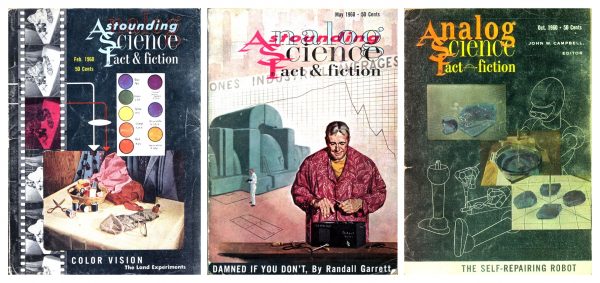
The full list of works published during Campbell’s tenure reads like a “Who’s Who of Science Fiction.” He was a man of strong opinions and although he did much for the field of science fiction, his regressive social views have lately come under fire. This has caused ANALOG SCIENCE FICTION AND FACT to drop the name of John W. Campbell from its annual prize for best new writer.
ANALOG after Campbell
Ben Bova succeeded Campbell as editor of ANALOG in 1972. Also a technophile with a scientific background, Bova immediately declared his intention to keep publishing stories with scientific foundations. Under his direction the character of the magazine changed, allowing fiction that included sexual content and profanity. Ben Bova won five consecutive Hugo Awards for his editing of ANALOG.
Bova was succeeded by Stanley Schmidt in 1978. Schmidt, an assistant professor of physics at the time of the transfer, continued the established editorial policies and a long-standing tradition of writing provocative editorials. Schmidt remained at the helm of ANALOG until 2012 when the current editor, Trevor Quachri, took over.
Says Quachri: “Real science and technology have always been important in ANALOG, not only as the foundation of its fiction, but as the subject of articles about real research with big implications for the future. . . . It’s true that we care very much about making our speculations plausible, because we think there’s something extra special about stories that are not only fantastic, but might actually happen.”
ANALOG comes out bi-monthly and issues are available in print and digital formats. With its January 2020 number, the magazine will begin a year-long celebration to honor its 90th anniversary. The ANALOG website can be found at: https://www.analogsf.com/.
When ASTOUNDING launched in the last month of 1929, Herbert Hoover was President. It was the beginning of the Great Depression, and Mickey Mouse had just made his first appearance. The dwarf planet, Pluto, wouldn’t be discovered until February 1930 and The Chrysler Building wouldn’t open until May. In India, Mohandas Gandhi was holding non-violent protest marches.
It’s hard to imagine that long-ago world when science fiction was in its infancy. It’s just as hard to image a world without ASTOUNDING/ANALOG. Science fiction would be nothing like we know it today. And that is an alternate reality I would not want to see.
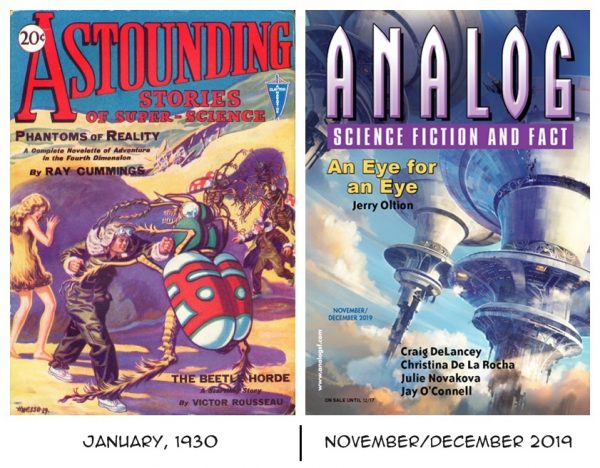
(Dated January 1930, the first issue of ASTOUNDING STORIES OF SUPER-SCIENCE — published by Clayton Publishing — appeared on America’s newsstands in December 1929, ninety years ago. The pulp featured front cover art by Hans Wessolowski, a German-born artist who entered the United State illegally in 1912. After establishing himself as a commercial artist in New York City, he began to sell interior art and cover paintings to various pulp magazines in 1928. His work was generally signed “Wesso.”
Hired by Street & Smith in 1937, John W. Campbell became the editor of ASTOUNDING STORIES after F. Orlin Tremaine was promoted to editorial director at Street & Smith. Campbell’s first issue of ASTOUNDING with full editorial control was dated March 1938, when the title of the magazine became ASTOUNDING SCIENCE-FICTION. The cover art is by Hans Wessolowski.
ASTOUNDING morphed into ANALOG over a series of issues in 1960. The change began with the February 1960 number, featuring an uncredited photographic cover. Behind the “Astounding” in the title bar are the letters “nalog,” outlined in red. Gradually, the “nalog” was brought more to the forefront, as in the May 1960 issue, with cover art by H. R. Van Dongen. A commercial artist, Van Dongen sold his first pulp cover painting to Popular Publications in 1950.
With the October 1960 number — with a cover sometimes credited to Campbell — the change was complete. “Astounding” completely disappeared from the title. Thereafter, the magazine was called ANALOG SCIENCE FACT — FICTION, or some variation thereof. The “Fact” and “Fiction” were flip-flopped in 1965. It became ANALOG SCIENCE FICTION AND FACT with the January 1993 issue, its current title. You can find the November/December 2019 number — with cover art by Tuomas Korpi — at book stores. The magazine’s 90th birthday issue — dated January/February 2020 — will go on sale on December 18, 2019.)

